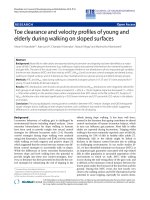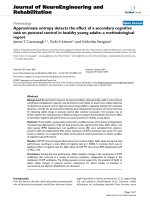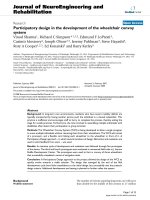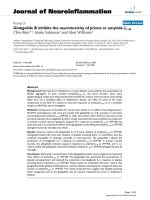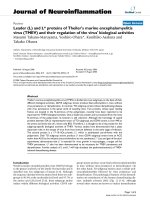Báo cáo hóa học: " Cytotoxic effects and the mechanism of three types of magnetic nanoparticles on human hepatoma BEL-7402 cells" ppt
Bạn đang xem bản rút gọn của tài liệu. Xem và tải ngay bản đầy đủ của tài liệu tại đây (934.27 KB, 10 trang )
NANO EXPRESS Open Access
Cytotoxic effects and the mechanism of three
types of magnetic nanoparticles on human
hepatoma BEL-7402 cells
Wei Kai
1,2
, Xu Xiaojun
3
, Pu Ximing
1,2
, Hou Zhenqing
1,2
and Zhang Qiqing
1,2,4*
Abstract
The evaluation of the toxicity of magnetic nanoparticles (MNPs) has attracted much attention in recent years. The
current study aimed to investigate the cytotoxic effects of Fe
3
O
4
, oleic acid-coated Fe
3
O
4
(OA-Fe
3
O
4
), and carbon-
coated Fe (C-Fe) nanoparticles on human hepatoma BEL-7402 cells and the mechanisms. WST-1 assay
demonstrated that the cytotoxicity of three types of MNPs was in a dose-dependent manner. G1 (Fe
3
O
4
and OA-
Fe
3
O
4
) phase and G2 (C-Fe) phase cell arrests and apoptosis induced by MNPs were detected by flow cytometry
analysis. The increase in apoptosis was accompanied with the Bax over-expression, mitochondrial membrane
potential decrease, and the release of cytochrome C from mitochondria into cytosol. Moreover, apoptosis was
further confirmed by morphological and biochemical hallmarks, such as swollen mitochondria with lysing cristae
and caspase-3 activation. Our results reveal ed that c ertain concentrations of the three types of MNPs affect BEL-
7402 cells viability via cell arrest and inducing apoptosis, and the MNPs-induced apoptosis is mediated through the
mitochondrial-dependent pathway. The influence potency of MNPs observed in all experiments would be: C-Fe >
Fe
3
O
4
> OA-Fe
3
O
4
.
Keywords: magnetic nanoparticles, BEL-7402, apoptosis, mitochondrial-dependent pathway, cell cycle
Introduction
Over the past few decades, as nanotechnology and materi-
als science has progressed incredibly swiftly, nanomaterials
have been widely applied in many f ields including medi-
cine, pharmaceuticals, manufacturing technologies, elec-
tronics, and telecommunications [1-3]. In particular,
the surge of interest in nanomaterials has significantly
expanded the breadth of research on magnetic nanoparti-
cles (MNPs) during the recent decade. Due to their multi-
functional properties, MNPs are explored for various
biomedical applications such as contrast agents for MRI
[4,5], targeted drug and gene delivery [6,7], cell sorting [8],
hyperthermia [9], or co mbinations of mult iple applica-
tions, both diagnostic and therapeutic [10]. Some MNPs,
such as bowel contrast agents (Lumiren
®
and Gastro-
mark
®
) and liver/spleen imaging (Endorem
®
and Feridex
IV
®
) [11,12], are already in the market. Moreover, the
potential applications of MNPs (e.g., bare Fe
3
O
4
and C-Fe)
have expanded into other fields including environmental
restoration [13,14] and agriculture [15-18]. Some
researches indicate that MNPs would accumulate in aqua-
tic organisms [19], crops [18] for further entry into the
food chain. Humans are therefore increasingly exposed to
various kinds of MNPs, directly or indirectly.
Along with the expanding applications of MNPs, the
potential toxic effects of MNPs have been of wide concern
[20-23]. Multiple results show that MNPs significantly
reduce cell viability of human macrophage, epithelial cell
lines [24], human mesothelioma [25], and inhibit the
normal formation of PC12 neuronal cell morphology [26].
At higher concentrations, DMSA-coated MNPs decreas e
mitochondrial activity of human fibroblasts [27].
Meanwhile, the cytotoxicity of MNPs is found in a dose-
dependent manner [26].
Nevertheless, the cytotoxicity data of MNPs is difficult
to compare since the toxic effects of MNPs are influenced
by many parameters such as size distribution, surface coat-
ing, magnetic properties, etc. [27]. Numerous studies can
* Correspondence:
1
Department of Chemistry, College of Chemistry and Chemical Engineering,
Xiamen University, Xiamen 361005, PR China
Full list of author information is available at the end of the article
Kai et al. Nanoscale Research Letters 2011, 6:480
/>© 2011 Kai et al; licensee Springe r. This is an Open Access artic le distributed under the terms of the Creative Commons Attribution
License (http://creativecommon s.org/licenses/by/2.0), which permits unrestricted use, distribution, and reproduction in any medium,
provided the original work is pro perly cited.
be found that, quite often, report on seemingly contradict-
ing findings since different cell types will interact with the
same particle in different ways [28]. Therefore, it is crucial
to choose the cell line for the cytotoxicity assessment of
specific MNPs. Several pharmacokinetic reports indicate
that liver is the most important organ involving the bioac-
cumulation and clearance procedures of MNPs [29-31].
Furthermore, the cytotoxicity studies of MNPs are limited
by the fact that cytology mechanism remained unexplored.
In the present study, human hepatoma BEL-7402 cell
line was selected as the model specimen for cytotoxicity
assessment, and the aims were to evaluate the cytotoxi-
city of Fe
3
O
4
,OA-Fe
3
O
4
, and C-Fe and to elucida te the
mechanisms of their cytotoxicities. MNPs internalization
was observed by transmission electron microscopy
(TEM) and cell viability was determined by tetrazolium
salt-based (WST-1) assay. For the study of the mechan-
ism of cytotoxicity, cell cycle and apoptosis were ana-
lyzed by flow cytometry. To further elucidate the
apoptosis pathway, the mitochondrial membrane poten-
tial (MMP), the Bax and cytochrome C protein expres-
sion, and caspase-3 activity were investigated.
Results and discussion
MNPs uptake by human hepatoma BEL-7402 cells
When cells were exposed to MNPs, most nanoparticles
were first adhered to the surface, internalized to the cells
by endocytosis, and accumulated in digestive vacuoles
[32]. Our TEM images results showed that all three kinds
of MNPs were incorporated into BEL-7402 cells after
24-h incubation at 0.5 mg/mL of concentration. The
MNPs were distributed on the cell membrane and inside
of cell. Some MNPs were observed enclosed by the inva-
ginated cell membrane (Figure 1A), suggesting that endo-
cytosis may involve the MNPs internalization process
[21]. Lysosomes containing MNPs and swollen mito-
chondria with lysing cristae were present in MNPs trea-
ted cells (Figure 1C-D), coinciding with some results
obtained in other MNPs [21,33]. Some cells showed
chromatin condensation, typical of apoptotic cell death,
and plenty of cytoplasmic vacuoles (Figure 1C-E). Treat-
ing with OA-Fe
3
O
4
induced less cell damage than that of
Fe
3
O
4
, while the C-Fe causes serious cell damage.
Untreated cells had none of these features (Figure 1B).
The dose-dependent cytotoxicity of nanoparticles
3-(4, 5-Dimethylthiazol-2-yl)-2, 5-diphenyltetrazolium
bromide and lactate dehydrogenase assays are frequently
adopted in assessing nanoparticle toxicity. These assays
are used in drug studies, but can lead to aberrant results
when using nanoparticles as they can sometimes inter-
fere with the assay components or the readout [34]. Due
to its convenience and great sensitivity, recently, the
WST-1 assay has become a very popular cytotoxicity
assay in the nanotoxicity study [22]. After 24 h exposure
at varying doses of Fe
3
O
4
,OA-Fe
3
O
4
,andC-FeMNPs,
BEL-7402 cell viabilities detected by the WST-1 assay
resulted i n explicit dose-dependent reduction (Figure 2).
The viabilities of BEL-7402 cells exposed to all three
typesofMNPswereabove60%attheconcentrationof
0.1 mg/mL and below. When the MNPs concentrations
increased more than 1 mg/mL, the cell viabilities
dropped to below 60%. The viabilities of cells exposed
to Fe
3
O
4
were lower than that to OA-Fe
3
O
4
,buthigher
than to C-Fe at all concentrations, which were corre-
lated with the TEM observations. The cytotoxicity is
thus very likely caused by particle overload to cells [35].
It is well known that the surface of BEL-7402 cells is
negatively charge. The MNPs absorbed by the cells
reduced with the decrease in positively charged surfaces
of MNPs due to the electrostatic effects, which could
affect the amount of MNPs entering the cells and
further affect cytotoxicity. In our results, the surface
charge of Fe
3
O
4
,OA-Fe
3
O
4
, and C-Fe were 14.4, 4.5,
and 23.7 mV, respectively, which w ere consistent with
WST-1 data trend.
MNPs influence on the cell cycle
The effects of various concentrations (0.05, 0.1, and
1 mg/mL) of the three kinds of MNPs on cell cycle pro-
gression and population distribution in BEL-7402 cells
were determined by flow cytometry. MNPs-induced
effects were detected by comparing the cell cycle profiles
between MNP-treated and -untreated cells. Results
demonstrated that all three types of MNPs were able to
affect cell cy cle distribution of BEL-7402 cells (Table 1).
After treated with Fe
3
O
4
and OA-Fe
3
O
4
MNPs at three
different concentrations (0.05, 0.1, and 1 mg/mL), the
ratio of G0/G1 phase cells increased 3.42%, 18.70%,
28.78% and 4.37%, 3.46%, 15.71% compared with control,
respectively. As for C-Fe, 2.85%, 3.21%, and 9.34% G2
phase cell increases were observed. A similar report also
showed that single-walled carbon nanotubes also caused
a G2 phase arrest in PC12 cells [36]. Therefore, the
mechanism of C-Fe MNPs on the cell cycle might be dif-
ferent with that of Fe
3
O
4
, and OA-Fe
3
O
4
MNPs.
Cells with reversibly damaged DNA will accumulate in
G1, S, or G2/M phase [36], while cells that carry irrever-
sibly damaged DNA will undergo apoptosis [37,38].
Hence, it is necessary to further analyze the cell apopto-
sis to fully interpret the toxic effects of MNPs on BEL-
7402 cells.
MNPs-induced apoptosis of BEL-7402 cells
To assess the extent and mode of cell death induced by
MNPs, Annexin-V/propidium iodide (PI) staining was
performed. Externalization of phosphatidylserine (PS)
seems to be a genera l feature of early stage apoptosis.
Kai et al. Nanoscale Research Letters 2011, 6:480
/>Page 2 of 10
Annexin V which has a strong Ca
2+
-dependent affinity
for PS [39] was used to measure the apoptotic rate of
BEL-7402 cells in response to the treatment of MNPs.
The BEL-7402 cells were labeled with annexin V-
fluorescein isothiocyanate (FITC)/PI. The Annexin V
-
/
PI
-
population was regarded as normal cells, while posi-
tive staining just for Annexin V was used as a measure
of early apoptosis and Annexin V
-
/PI
+
was related to
A
B
C
E
A1
D
Figure 1 TEM micrographs of BEL-7 402 exposed for 24 h to the different MNPs.(A) TEM micrographs of cell endocytosis; (A1)the
enlargement of the rectangular areas on the corresponding images on the left side; (B) untreated cells; (C) cells exposed 0.5 mg/mL Fe
3
O
4
MNPs; (D) cells exposed 0.5 mg/mL OA- Fe
3
O
4
MNPs; (E) cells exposed 0.5 mg/mL C-Fe MNPs. Red circles show MNPs in the BEL-7402 cells.
Kai et al. Nanoscale Research Letters 2011, 6:480
/>Page 3 of 10
late apoptosis or necrosis [40]. Statistical data were
extracted from the dot plots using WinMDI software
[37]. As shown in Figure 3, compared with the
untreated cells, a significant increase in the ratio of
apoptosis cell was observed in Fe
3
O
4
and C-Fe MNPs
(0.05 mg/mL) treated cells (P < 0.05, the probability
values of P < 0.05 were considered as statistics signifi-
cance). At high conce ntration (1 mg/mL), all MNPs
cause serious cell apoptosis (P < 0.01). Besides, a dose-
dependent apoptosis rate was observed in all three types
of MNP-treated cells. Moreover, the apoptosis rate of
cells exposed to three types of MNPs would be: C-Fe >
Fe
3
O
4
> OA-Fe
3
O
4
, in the same concentration.
This apoptosis result is consistent w ith cytotoxicity
trends shown in WST-1 assay. The mechanisms of cyto-
toxic effects of MNPs o n BEL-7402 cells may be imple-
mented through cell cycle arrest and inducing apoptosis.
Assay of mitochondria-dependent apoptosis in BEL-7402
cells after MNPs
Apoptosis is a tightly controlled process in which cell
death is executed through the activation of specific sig-
naling pathways [41,42]. Although it is well established
that many organelles contrib ute to apoptosis, extensive
research shows that nanoparticles induced cell apoptosis
via mitochondria-dependent pathway [43,44]. As an indi-
cative of mitochondria involvement in the apoptosis, the
appar ently swoll en mitochondria with lysing cristae wer e
observed by TEM (Figure 1). Therefore, we spe culate
that BEL-7402 cell apoptosis was induced by MNPs
through mitochondria-dependent pathway.
The mitochondrion is an important organelle involved
in apoptosis. The loss of MMP is putatively the initial
event leading to apoptosis [45]. To further elucidate the
molecular mechanism of MNPs-induced apoptosis in
BEL-7402, we examined loss of MMP using flow cytome-
try. As illustrated in Figure 4, after 24-h exposure to
MNPs (0.05 mg/mL) for 24 h, a significant decrease in
MMP was only observed in C-Fe-treated group (P < 0.05),
while at high concentration (1 mg/mL), significant
decrease of MMP occurred in all three MNPs-treated
groups (P < 0.05).
Mitochondrial membrane permeability is r egulated
through a family of proto-oncogenes. Bax is an important
pro-apoptotic protein of the Bcl-2 family members [46].
High level of Bax can translocate to the outer mitochon-
drial membrane (OMM) and insert into the OMM. Then,
Bax for ms oligomers that are thought to be important in
the formation of the mitochondrial permeability transition
0
20
40
60
80
100
120
0.01 0.05 0.1 0.5 1 2
MNPs concentration (m
g
/mL)
C
ell V
i
ab
i
l
i
ty
(%
o
f
C
ontrol
)
Fe3O4
oleic acid-Fe3O4
C-Fe
Figure 2 The viability of BEL-7402 Cells incubated with MNPs.
Cells viability was determined by WST-1 assay after BEL-7402 cells
were treated with MNPs (0.01, 0.05, 0.1, 0.5, 1, and 2 mg/mL) for
24 h. The percentage of viable cells was calculated as a ratio of
absorbance at 490 nm of treated to control cells.
Table 1 MNPs affected cell cycle distribution of BEL-7402
cells
Cell cycle (%)
G0-G1 S G2
Control 60.13 32.65 7.22
Fe
3
O
4
0.05 mg/mL 63.55 26.72 9.73
0.1 mg/mL 78.83* 14.09* 7.08
1 mg/mL 88.91 3.52** 7.57
OA-Fe
3
O
4
0.05 mg/mL 64.50 30.37 5.13
0.1 mg/mL 63.59 29.75 6.67
1 mg/mL 75.84* 21 3.15
C-Fe 0.05 mg/mL 59.32 30.61 10.07
0.1 mg/mL 65.96 23.61 10.43
1 mg/mL 56.56 26.88 16.56*
After BEL-7402 cells were treated with MNPs (0.05 and 1 mg/mL) for 24 h, cell
cycle assay was carried out by PI staining using flow cytometry. *P < 0.05 vs.
control; **P < 0.01 vs. control.
0
0.2
0.4
0.6
0.8
1
Control 0.05 mg/mL
F
e3O
4
0.05 mg/mL
O
A-F
e3O
4
0.05 mg/mL
C
-F
e
1 mg/mL
C
-F
e
1 mg/mL
C
-F
e
1 mg/mL
C
-F
e
Events (%)
Live cells Early apoptosis Late apoptosis or Necrosis
*
*
**
**
**
Figure 3 MNPs induced apoptosis of BEL-7402 cells by
Annexin V/PI assay. Annexin V-FITC/PI assay shows cell apoptosis
by flow cytometry. Exposure of BEL-7402 cells to MNPs (0.05 and 1
mg/mL) for 24 h increased cell apoptosis. *P < 0.05 vs. control; **P
< 0.01 vs. control.
Kai et al. Nanoscale Research Letters 2011, 6:480
/>Page 4 of 10
pore (PTP) [47,48]. The opening of the mitochondrial PTP
can lead to a release of cytochrome C, which is a key event
in apoptosis via the mitochondria-mediated pathway [49].
We examined expression of Bax and cytochrome C by
Western blot. As shown in Figure 5A-B, after 24 h expo-
sure at low concentration (0.05 m g/mL) of MNPs, t he
expression of Bax protein slightly increased, while without
significant differences (P > 0.05). At high concentration
(1 mg/mL), Bax protein expression in Fe
3
O
4
,OA-Fe
3
O
4
,
and C-Fe MNPs-treated groups were about 1.94, 1.89, and
2.43 times compared with the control group, respectively.
As for cytochrome C, the pr otein e xpression slightly
decreased at the low concentration, while without signifi-
cant differences (P >0.05).Athighconcentration,the
cytochrome C protein expression of all treated groups
decreased dramatically, which is consistent with tendency
of MMP. Based on the results mentioned above, we con-
cluded that the three types of MNPs could induce Ba x
expression, further open PTP, and the PTP opening led to
the release of cytochrome C from mitochondria. Once
released from the mitochondria, cytochrome C combines
with procas pase-9 to form the “apoptosome” ,which
further activates caspase-3 [50-52]. Caspase-3 has been
identified as a key mediator of apoptosis of mammalian
cells [53]. Its activity is considered to be an appropriate
measure of cytotoxic responsiveness [54]. We investigated
the activaty of caspases-3 in BEL-7402 after exposure to
MNPs for 24 h. As shown in Figure 6, we found that all
three types of MNPs can activate caspase-3 in a dose-
dependent manner. At low c oncentration (0.05 mg/mL),
the activity of caspase-3 of the experimental groups
increased, with significant differences found in Fe
3
O
4
-and
C-Fe-treated groups (P < 0.05). The acti vity of caspase-3
was significantly increased in all experimental groups at
high concentration (1 mg/mL) (P < 0.05).
To sum up, our results indeed suggested that all three
types of MNPs can induce apoptosis in BEL-7402 cells
through mitochondria-dependent pathway. Moreover,
the influence potency of MNPs on the mitochondria-
dependent apoptosis would be: C-Fe > Fe
3
O
4
>OA-
Fe
3
O
4
, and all in a dose-dependent manner.
Conclusion
In this paper, cytotoxic effects and the mechanism of
Fe
3
O
4
,OA-Fe
3
O
4
, and C-Fe MNPs on BEL-7402 cells
were studied. A dose-dependent cytotoxicity pattern was
found in all three types of MNPs via WST-1 assay. The
results of flow cytometric analysis revealed that the
cytotoxicit y of MNPs is implemented through cell cycle
arrest and inducing apoptosis. The results of mitochon-
drial membrane potential, Western blots for Bax and
cytochrome C, and caspase-3 activation further elucidate
that MNPs induce apoptosis through mitochondria-
dependent pathway. Moreover, the influ ence potency of
MNPs observed in all experiments would be: C-Fe >
Fe
3
O
4
> OA-Fe
3
O
4
.
Recent studies show that the cytotox icities of many
MNPs could be due to reactive oxygen species (ROS)
induction [55,56]. And accompanied with the MNPs
degradation, the altered cellular iron pool can then
affect cellular functionality by altering the level of trans-
ferrin receptor expression and can affect cellular prolif-
eration capacity by altering the expression of cyclins and
cyclin-dependent kinases in cell cycle [57,58]. Therefore,
the metabolism, ROS determination and transferrin
receptor expression will be the next step for further
reveal of the cytotoxicities of Fe
3
O
4
,OA-Fe
3
O
4
,and
C-Fe.
Materials and methods
Reagents
RPMI-1640 and fetal bovine serum we re purchased from
Gibco, Invitrogen Corp., Carlsbad, CA, USA. PI and
RNase I were obtained from Sigma, St. Louis, MO, USA.
Alexa Fluor
®
488 annexin V/Dead Cell Apoptosis Kit was
obtained from Invitrogen, USA. The primary antibodies to
Bax, cytochrome C, and b-actin were purchased from
Santa Cruz Biotechnology (Santa Cruz, CA, USA). The
goat anti-Mouse IgG-HRP, mouse anti-rabbit IgG-HRP,
and Potent ECL kit were purch ased from Multisciences,
Hanzhou, China. Caspase-3/CPP32 Colorimetric Assay Kit
and Mitochondria/Cytosol Fractionation Kit were pur-
chased from BioVision, Mountain View, CA, USA. Total
Protein Extraction Kit and BCA Protein Assay Kit were
obtained from Applygen Technologies Inc., Beijing, China.
The lipophilic cationic dye JC-1 (5, 5, 6, 6-tetrachloro-1, 1,
3, 3-tetraethy lbenzimidazol-carbocyanine iodide) was
0
20
40
60
80
100
120
F
e3O
4
O
A-F
e3O
4
C
-F
e
Membrane Potent
i
a
l
(% of Control)
0.05mg/ml
1mg/ml
γγ
γ γ
γ
γ
Figure 4 MNPs-induced loss of MMP. The MMP was measured by
flow cytometry using JC-1 dye. Exposure of BEL-7402 cells to three
types of MNPs (0.05 and 1 mg/mL) for 24 h decreased the MMP.
*P < 0.05 vs. control; **P < 0.01 vs. control.
Kai et al. Nanoscale Research Letters 2011, 6:480
/>Page 5 of 10
0
0.5
1
1.5
2
2.5
3
0.05mg/mL 1mg/mL
Relative Density ( Control=1)
Control
Fe3 O4
OA-Fe3O4
C-Fe
B
*
*
*
0
0.2
0.4
0.6
0.8
1
1.2
0.05m
g
/mL 1m
g
/mL
Relative Density (Control=1)
Control
Fe3 O4
OA-Fe3O4
C-Fe
D
*
*
**
Figure 5 MNPs induced Bax over-expression and Cytochrome C release. U p-regulati on of Bax expression in BEL-7402 cells treated with
MNPs (A) and plotted as a relative level (B); down-regulation of cytochrome C expression in BEL-7402 cells treated with MNPs (C) and plotted as
a relative level ( D)*P < 0.05 vs. control; **P < 0.01 vs. control.
Kai et al. Nanoscale Research Letters 2011, 6:480
/>Page 6 of 10
obtained from ChemoMetec, Allerød, Denmark. WST-1
Cell Proliferation and Cytotoxicity Assay Kit was pur-
chased from Beyotime Institute of Biotechnology, Haimen,
China. All other reagents are analytical or cultured grade
purity.
Cell culture and preparation of MNPs
Human hepatoma BEL-7402 cell line was a gift kindly
provided by Medical College of Xiamen University (Xia-
men, China). The cells were cultured in RPMI-1640
medium supplemented with 10% heat-inactivated fetal
bovine serum. Incubation was carried out at 37°C in a
humidified 5% CO
2
incubator. For all experiments, the
cells were in the exponential growth phase. The MNPs
used in this study were: (1) Fe
3
O
4
MNPs, purchased
from Aladdin (Shanghai, China); (2) OA-Fe
3
O
4
MNPs,
purchased from Jinke (Maanshan, China); (3) C-Fe
MNPs, purchased from Junye (Shenzhen, China). The
purity of three types MNPs are 99.9% and the size dis-
tribution of particles are 10-30 nm. Nanoparticle stock
suspensions (10 mg/mL) were prepared by UV-steriliza-
tion and dispersing a known weight of nanoparticles in
RPMI-1640 medium under ultrasonication. The stock
suspensions were sonicated for 20 min to distribute the
particles, and then dilutions were made in complete
media to achieve desired testing concentrations. The
test suspensions were sonicated for 20 min before use.
Untreated controls were exposed to complete media
only, and processed identical to the exposed cells.
TEM analysis
Cells (2 × 10
6
) were seeded into 100-cm
2
petri dishes.
Cells were allowed to attach for 24 h and were then trea-
ted with each MNPs test suspensions for 24 h in a con-
centration of 0.5 mg/mL. Then, the ce lls were collected
and fixed with 2.5% glutaraldehyde buffered in 0.1 M
PBS overnight at 4°C. The samples were washed with
PBS,andpost-fixedin1%osmiumtetroxideat4°Cfor
1 h. After dehydration in series concentrations of ethanol
and infiltration in acetone, cells were em bedded in Epon
812, and ultra-thin sections cut with glass knives were
stained with uranyl acetate and lead citrate, and viewed
under JEM 2100 TEM (JEOL, Tokyo, Japan).
WST-1 assay
To determine cell toxicity/viability, BEL-7402 cel ls (0.5
×10
4
,100μL) were plated onto 96-multiwell plates
(Costar, Corning, NY, USA) and incubated for 24 h.
Then, cells were exposed to various concentrations
(0.01-2 mg/mL) of each MNPs test suspensions for
24 h. Afterwards, the old media was discarded and
replaced with 100 μL of new complete media. WST-1
solution (10 μL) was added to each well, followed by
incubation for 2.5 h. Absorbance at 490 nm (referen ce
at 630 nm) was measured by a spectrophotometric
microplate reader (Bi o-tek ELX800, BioTek Instruments,
Winooski,VT1,USA).Anegativecontrolwasprovided
using the culture medium without the nanoparticles.
Each of the particle concentrations and the controls was
seeded in eight wells. The percentage cell viability was
calculated in term of absorbency in cells treated with
MNPs relative to that in cells exposed to culture media
alone.
Cell cycle assay
A cell cycle assay was carried out by staining the DNA
with PI and analyzing the fluorescence using flow cyto-
metry. Following exposure of the BEL-7402 cells to each
MNPs for 24 h, any damaged cells can detach from the
plate and become suspended in the medium, necessitat-
ing medium storage. Briefly, the cells were harvested,
washed with PBS, and fixed in ice-cold 70% of ethanol
at -20°C before use. After resuspension, cells were
wash ed, and incubated with 100 μL PI (400 μg/mL) and
100 μL RNase I (1 mg/mL) at 37°C for 15 min. Cells
were analyzed with an EPICS XL flow cytometer (Beck-
man Coulter Inc., Fullerton, CA, USA) and the data
were consequently evaluated by Mod-Fit (Verity Soft-
ware, Topsham, ME, USA).
Detection of apoptosis by annexin V assay
Apoptosis was evaluated using Alexa Fluor
®
488
Annexin V/PI Apoptosis Kit. BEL-7402 cells were
0
0.5
1
1.5
2
2.5
3
3.5
4
F
e3O
4
O
A-F
e3O
4
C
-F
e
Caspase-3 Activity (control=1)
0.05 mg/mL
1 mg/mL
**
*
**
*
*
Figure 6 Caspase-3 activity of BEL-7402 cells after incubation
with MNPs for 24 h. After BEL-7402 cells were treated with MNPs
(0.05 and 1 mg/mL) for 24 h, caspase-3 activity was determined
using caspase-3/CPP32 Colorimetric Assay Kit. *P < 0.05 vs. control;
**P < 0.01 vs. control.
Kai et al. Nanoscale Research Letters 2011, 6:480
/>Page 7 of 10
treated with two concentrations (0.05 and 1 mg/mL) o f
each MNPs for 24 h. After exposure, the cells (5-10 ×
10
4
) were harvested, washed and resuspended with PBS.
The Annexin V/PI staining of cells followed the manu-
facturer’s instructions. Then the samples were analyzed
with EPICS XL flow cytometer (Beckman Coulter,
USA).Theresultswereexpressedasthenumberof
apoptotic cells per thousand cells counted.
MMP measurement
The mitochondrial membrane potential was measu red by
flow cytometry using JC-1 dye. JC-1 changes its fluores-
cence from green at 535 nm (monomer state) to orange
at 590 nm (aggregate state) as it enters in mitochondria
of intact cells. When the mitochondrial membrane
potential is affected, JC-1 returns to its green monomeric
state. All procedures were carried out according to the
manufacturer ’s instructions. The cell treatments were the
same with “Detection of apoptosis by annexin V assay”
section. In brief, approximately 2 × 10
6
cells were har-
vested, washed, resuspended in PBS (1 mL) and stained
with 12.5 μLJC-1(200μg/mL)for15minat37°Cinthe
dark. Both fluorescences emitted by the cells were moni-
tored by flow cytometry and the ratio orange/green fluor-
escence was calculated. The data was determined by
analyzing 10,000 cells using an EPICS XL flow cyt ometer
(Beckman Coulter, Fullerton,CA,USA),andCellQuest
software (Becton Dickinson, San Jose, CA, USA).
Western blot analysis of Bax and cytochrome C
The cell treatments were the same with “ Detec tion of
apoptosis by annexin V assay” section. Approximately 1
×10
7
cells per sample were harvested. The protein sam-
ples of Bax and cytochrome C were extracted using
Total Protein Extraction Kit and Mitochondria/Cytosol
Fractionation Kit, respectively. Protein contents were
quantified using the BCA protein assay kit and stored at
-70°C. Protein (20 μg per lane) was resolved by 12%
sodium dodecyl sulfate-polyacrylamide gel electrophor-
esis (SDS-PAGE), and transferred to nitrocellulose
membranes (PVDF, Millipore Corporation, Billerica,
MA, USA). The transblotted membrane was washed,
blocked, and incubated at 4°C overnight with anti-Bax
antibody and anti-cytochrome C antibody, respectively.
Immunodetection with the secondary HRP-conjugated
antibody and chemilumin escence using Potent ECL Kit
were performed according to the manufacturer’sproto-
col. Equal protein loading was verified by probing with
anti-b actin antibody. Densitometric analysis for the
blots was performed with Bandscan image software.
Caspase-3 activity assay
The activity of caspase-3 was determined using caspase-
3/CPP32 Colorimetric Assay K it. The cell treatments
were the same with “Detection of apoptosis by annexin V
assay” section. All procedures were carried out according
to the manufacturer’s instructions. Briefly, 2 × 10
7
BEL-
7402 cells were lysed by the solution provided in the
assay kit and the protein concentration was measured
using BCA protein assay kit. For caspase-3 activity assay,
equal amounts of total cell lysates were mixed with a cas-
pase-specific substrate D EVD-pNA in a 96-well plate in
triplicate. After incubation at 37°C for 2 h, the caspase-3-
mediated cleavage of DEVD-pNA into free pNA was
measured using spectrophotometric microplate reader
(Bio-tekELX800,USA)at405nm.Theresultswere
expressed as absorbance compared with control.
Statistical analysis
All results were expressed as mean values ± S.D. Statis-
tical analysis was performed according to the Student’s t
test. The probabilit y values of P < 0.05 were considered
as significant.
Acknowledgements
This work was financially supported by the Major Research plan of the
National Natural Science Foundation of China (Grant No. 90923042), National
Key Technologies R & D Program of China (Grant No. 2007BAD07B05).
Author details
1
Department of Chemistry, College of Chemistry and Chemical Engineering,
Xiamen University, Xiamen 361005, PR China
2
Research Center of Biomedical
Engineering, Department of Materials Science and Engineering, College of
Materials, Xiamen University, Technology Research Center of Biomedical
Engineering of Xiamen City, The Key Laboratory of Biomedical Engineering
of Fujian Province, Xiamen 361005, PR China
3
Zhejiang Fishery Technical
Extention Center, Hangzhou 310012, PR China
4
Institute of Biomedical
Engineering, Chinese Academy of Medical Science and Peking Union
Medical College, The Key Laboratory of Biomedical Material of Tianjin, Tianjin
300192, PR China
Authors’ contributions
WK conceived the study, carried out all the experiments and drafted the
manuscript. XXJ collected and analysed data, drafted the manuscript and
approved the final version. PXM participated in drafting the manuscript. HZQ
reviewed the manuscript. ZQQ conceived the study, reviewed the
manuscript and approved the final version.
Competing interests
The authors declare that they have no competing interests.
Received: 7 April 2011 Accepted: 29 July 2011 Published: 29 July 2011
References
1. M G: Travels to the nanoworld: miniature machinery in nature and
technology. New York: Plenum Trade; 1999.
2. Kim D, El-Shall H, Dennis D, Morey T: Interaction of PLGA nanoparticles
with human blood constituents. Colloids Surf B Biointerfaces 2005,
40:83-91.
3. Perkel JM: Nanoscience is Out of the Bottle. The scientist 2003, 17:20-23.
4. Boutry S, Laurent S, Elst LV, Muller RN: Specific E-selectin targeting with a
superparamagnetic MRI contrast agent. Contrast Media Mol Imaging 2006,
1:15-22.
5. Mornet S, Vasseur S, Grasset F, Veverka P, Goglio G, Demourgues A,
Portier J, Pollert E, Duguet E: Magnetic nanoparticle design for medical
applications. Progress in Solid State Chemistry 2006, 34:237-247.
6. Dobson J: magnetic nanoparticles for drug delivery. Drug Development
Research 2006, 67:55-60.
Kai et al. Nanoscale Research Letters 2011, 6:480
/>Page 8 of 10
7. Mykhaylyk O, Zelphati O, Hammerschmid E, Anton M, Rosenecker J, Plank C:
Recent advances in magnetofection and its potential to deliver siRNAs
in vitro. Methods Mol Biol 2009, 487:111-146.
8. Clement JH, Schwalbe M, Buske N, Wagner K, Schnabelrauch M, Gornert P,
Kliche KO, Pachmann K, Weitschies W, Hoffken K: Differential interaction of
magnetic nanoparticles with tumor cells and peripheral blood cells.
J Cancer Res Clin Oncol 2006, 132:287-292.
9. Gazeau F, Levy M, Wilhelm C: Optimizing magnetic nanoparticle design
for nanothermotherapy. Nanomedicine (Lond) 2008, 3:831-844.
10. Weinstein JS, Varallyay CG, Dosa E, Gahramanov S, Hamilton B, Rooney WD,
Muldoon LL, Neuwelt EA: Superparamagnetic iron oxide nanoparticles:
diagnostic magnetic resonance imaging and potential therapeutic
applications in neurooncology and central nervous system inflammatory
pathologies, a review. J Cereb Blood Flow Metab 2010, 30:15-35.
11. Wang YX, Hussain SM, Krestin GP: Superparamagnetic iron oxide contrast
agents: physicochemical characteristics and applications in MR imaging.
Eur Radiol 2001, 11:2319-2331.
12. Bonnemain B: Superparamagnetic agents in magnetic resonance
imaging: physicochemical characteristics and clinical applications. A
review. J Drug Target 1998, 6:167-174.
13. Shen YF, Tang J, Nie ZH, Wang YD, Ren Y, Zuo L: Preparation and
application of magnetic Fe3O4 nanoparticles for wastewater purification.
Separation and Purification Technology 2009, 68:312-319.
14. Zhang D, Wei S, Kaila C, Su X, Wu J, Karki AB, Young DP, Guo Z: Carbon-
stabilized iron nanoparticles for environmental remediation. Nanoscale
2010, 2:917-919.
15. Scheenen TW, Vergeldt FJ, Heemskerk AM, Van As H: Intact plant magnetic
resonance imaging to study dynamics in long-distance sap flow and
flow-conducting surface area. Plant Physiol 2007, 144:1157-1165.
16. Gonzalez-Melendi P, Fernandez-Pacheco R, Coronado MJ, Corredor E,
Testillano PS, Risueno MC, Marquina C, Ibarra MR, Rubiales D, Perez-de-
Luque A: Nanoparticles as smart treatment-delivery systems in plants:
assessment of different techniques of microscopy for their visualization
in plant tissues. Ann Bot 2008, 101:187-195.
17. Corredor E, Testillano PS, Coronado MJ, Gonzalez-Melendi P, Fernandez-
Pacheco R, Marquina C, Ibarra MR, de la Fuente JM, Rubiales D, Perez-de-
Luque A, Risueno MC: Nanoparticle penetration and transport in living
pumpkin plants: in situ subcellular identification. BMC Plant Biol 2009,
9:45.
18. Cifuentes Z, Custardoy L, de la Fuente JM, Marquina C, Ibarra MR,
Rubiales D, Perez-de-Luque A: Absorption and translocation to the aerial
part of magnetic carbon-coated nanoparticles through the root of
different crop plants. J Nanobiotechnology 2010, 8:26.
19. Moore MN: Do nanoparticles present ecotoxicological risks for the health
of the aquatic environment? Environ Int 2006, 32:967-976.
20. Service RF: Nanotoxicology. Nanotechnology grows up. Science 2004,
304:1732-1734.
21. Zhang S, Chen X, Gu C, Zhang Y, Xu J, Bian Z, Yang D, Gu N: The
Effect of
Iron Oxide Magnetic Nanoparticles on Smooth Muscle Cells. Nanoscale
Res Lett 2009, 4:70-77.
22. Ying E, Hwang HM: In vitro evaluation of the cytotoxicity of iron oxide
nanoparticles with different coatings and different sizes in A3 human T
lymphocytes. Sci Total Environ 2010, 408:4475-4481.
23. Wu X, Tan Y, Mao H, Zhang M: Toxic effects of iron oxide nanoparticles
on human umbilical vein endothelial cells. Int J Nanomedicine 2010,
5:385-399.
24. Soto K, Garza KM, Murr LE: Cytotoxic effects of aggregated nanomaterials.
Acta Biomater 2007, 3:351-358.
25. Brunner TJ, Wick P, Manser P, Spohn P, Grass RN, Limbach LK, Bruinink A,
Stark WJ: In vitro cytotoxicity of oxide nanoparticles: comparison to
asbestos, silica, and the effect of particle solubility. Environ Sci Technol
2006, 40:4374-4381.
26. Pisanic TR, Blackwell JD, Shubayev VI, Finones RR, Jin S: Nanotoxicity of
iron oxide nanoparticle internalization in growing neurons. Biomaterials
2007, 28:2572-2581.
27. Auffan M, Decome L, Rose J, Orsiere T, De Meo M, Briois V, Chaneac C,
Olivi L, Berge-Lefranc JL, Botta A, Wiesner MR, Bottero JY: In vitro
interactions between DMSA-coated maghemite nanoparticles and
human fibroblasts: a physicochemical and cyto-genotoxical study.
Environ Sci Technol 2006, 40:4367-4373.
28. Barua S, Rege K: Cancer-cell-phenotype-dependent differential
intracellular trafficking of unconjugated quantum dots. Small 2009,
5:370-376.
29. Chouly C, Pouliquen D, Lucet I, Jeune JJ, Jallet P: Development of
superparamagnetic nanoparticles for MRI: effect of particle size, charge
and surface nature on biodistribution. J Microencapsul 1996, 13:245-255.
30. Briley-Saebo K, Bjornerud A, Grant D, Ahlstrom H, Berg T, Kindberg GM:
Hepatic cellular distribution and degradation of iron oxide nanoparticles
following single intravenous injection in rats: implications for magnetic
resonance imaging. Cell Tissue Res 2004, 316:315-323.
31. Jain TK, Reddy MK, Morales MA, Leslie-Pelecky DL, Labhasetwar V:
Biodistribution, clearance, and biocompatibility of iron oxide magnetic
nanoparticles in rats. Mol Pharm 2008, 5:316-327.
32. Tomitaka A, Hirukawa A, Yamada T, Morishita S, Takemura Y:
Biocompatibility of various ferrite nanoparticles evaluated by in vitro
cytotoxicity assays using HeLa cells. Journal of Magnetism and Magnetic
Materials 2009, 321:1482-1484.
33. Gojova A, Guo B, Kota RS, Rutledge JC, Kennedy IM, Barakat AI: Induction
of inflammation in vascular endothelial cells by metal oxide
nanoparticles: effect of particle composition. Environ Health Perspect 2007,
115:403-409.
34. Soenen SJ, De Cuyper M: Assessing cytotoxicity of (iron oxide-based)
nanoparticles: an overview of different methods exemplified with
cationic magnetoliposomes. Contrast Media Mol Imaging 2009, 4:207-219.
35. Gupta AK, Curtis AS:
Lactoferrin and ceruloplasmin derivatized
superparamagnetic
iron oxide nanoparticles for targeting cell surface
receptors. Biomaterials 2004, 25:3029-3040.
36. Wang J, Sun P, Bao Y, Liu J, An L: Cytotoxicity of single-walled carbon
nanotubes on PC12 cells. Toxicol in Vitro 2011, 25:242-250.
37. AshaRani PV, Low Kah Mun G, Hande MP, Valiyaveettil S: TEM Cytotoxicity
and genotoxicity of silver nanoparticles in human cells. ACS Nano 2009,
3:279-290.
38. Ishikawa K, Ishii H, Saito T: DNA damage-dependent cell cycle
checkpoints and genomic stability. DNA Cell Biol 2006, 25:406-411.
39. Merdan T, Kopecek J, Kissel T: Prospects for cationic polymers in gene
and oligonucleotide therapy against cancer. Adv Drug Deliv Rev 2002,
54:715-758.
40. Wang ZY, Zhao Y, Ren L, Jin LH, Sun LP, Yin P, Zhang YF, Zhang QQ: Novel
gelatin-siloxane nanoparticles decorated by Tat peptide as vectors for
gene therapy. Nanotechnology 2008, 19.
41. Cho SG, Choi EJ: Apoptotic signaling pathways: caspases and stress-
activated protein kinases. J Biochem Mol Biol 2002, 35:24-27.
42. Ho PK, Hawkins CJ: Mammalian initiator apoptotic caspases. FEBS J 2005,
272:5436-5453.
43. Chen X, Deng C, Tang S, Zhang M: Mitochondria-dependent apoptosis
induced by nanoscale hydroxyapatite in human gastric cancer SGC-7901
cells. Biol Pharm Bull 2007, 30:128-132.
44. Woldemariam GA, Mandal SS: Iron(III)-salen damages DNA and induces
apoptosis in human cell via mitochondrial pathway. Journal of Inorganic
Biochemistry 2008, 102:740-747.
45. Petit PX, Susin SA, Zamzami N, Mignotte B, Kroemer G: Mitochondria and
programmed cell death: back to the future. FEBS Lett 1996, 396:7-13.
46. Wang X, Xia Y, Liu L, Liu M, Gu N, Guang H, Zhang F: Comparison of MTT
assay, flow cytometry, and RT-PCR in the evaluation of cytotoxicity of
five prosthodontic materials. J Biomed Mater Res B Appl Biomater 2010,
95:357-364.
47. Antonsson B, Montessuit S, Sanchez B, Martinou JC: Bax is present as a
high molecular weight oligomer/complex in the mitochondrial
membrane of apoptotic cells. J Biol Chem 2001, 276:11615-11623.
48. Yethon JA, Epand RF, Leber B, Epand RM, Andrews DW: Interaction with a
membrane surface triggers a reversible conformational change in Bax
normally associated with induction of apoptosis. J Biol Chem 2003,
278:48935-48941.
49. Matroule JY, Carthy CM, Granville DJ, Jolois O, Hunt DW, Piette J:
Mechanism of colon cancer cell apoptosis mediated by
pyropheophorbide-a methylester photosensitization. Oncogene 2001,
20
:4070-4084.
50.
Launay S, Hermine O, Fontenay M, Kroemer G, Solary E, Garrido C: Vital
functions for lethal caspases. Oncogene 2005, 24:5137-5148.
Kai et al. Nanoscale Research Letters 2011, 6:480
/>Page 9 of 10
51. Suzuki N, Urano J, Tamanoi F: Farnesyltransferase inhibitors induce
cytochrome c release and caspase 3 activation preferentially in
transformed cells. Proc Natl Acad Sci USA 1998, 95:15356-15361.
52. Li P, Nijhawan D, Budihardjo I, Srinivasula SM, Ahmad M, Alnemri ES,
Wang X: Cytochrome c and dATP-dependent formation of Apaf-1/
caspase-9 complex initiates an apoptotic protease cascade. Cell 1997,
91:479-489.
53. Kothakota S, Azuma T, Reinhard C, Klippel A, Tang J, Chu K, McGarry TJ,
Kirschner MW, Koths K, Kwiatkowski DJ, Williams LT: Caspase-3-generated
fragment of gelsolin: effector of morphological change in apoptosis.
Science 1997, 278:294-298.
54. Sonnemann J, Gange J, Pilz S, Stotzer C, Ohlinger R, Belau A, Lorenz G,
Beck JF: Comparative evaluation of the treatment efficacy of
suberoylanilide hydroxamic acid (SAHA) and paclitaxel in ovarian cancer
cell lines and primary ovarian cancer cells from patients. BMC Cancer
2006, 6:183.
55. Soenen SJ, Himmelreich U, Nuytten N, Pisanic TR, Ferrari A, De Cuyper M:
Intracellular nanoparticle coating stability determines nanoparticle
diagnostics efficacy and cell functionality. Small 2010, 6:2136-2145.
56. Stroh A, Zimmer C, Gutzeit C, Jakstadt M, Marschinke F, Jung T, Pilgrimm H,
Grune T: Iron oxide particles for molecular magnetic resonance imaging
cause transient oxidative stress in rat macrophages. Free Radic Biol Med
2004, 36:976-984.
57. Schäfer R, Kehlbach R, Wiskirchen J, Bantleon R, Pintaske J, Brehm BR,
Gerber A, Wolburg H, Claussen CD, Northoff H: Transferrin receptor
upregulation: in vitro labeling of rat mesenchymal stem cells with
superparamagnetic iron oxide. Radiology 2007, 244:514-523.
58. Huang DM, Hsiao JK, Chen YC, Chien LY, Yao M, Chen YK, Ko BS, Hsu SC,
Tai LA, Cheng HY, Wang SW, Yang CS, Chen YC: The promotion of human
mesenchymal stem cell proliferation by superparamagnetic iron oxide
nanoparticles. Biomaterials 2009, 30:3645-3651.
doi:10.1186/1556-276X-6-480
Cite this article as: Kai et al.: Cytotoxic effects and the mechanism of
three types of magnetic nanoparticles on human hepatoma BEL-7402
cells. Nanoscale Research Letters 2011 6:480.
Submit your manuscript to a
journal and benefi t from:
7 Convenient online submission
7 Rigorous peer review
7 Immediate publication on acceptance
7 Open access: articles freely available online
7 High visibility within the fi eld
7 Retaining the copyright to your article
Submit your next manuscript at 7 springeropen.com
Kai et al. Nanoscale Research Letters 2011, 6:480
/>Page 10 of 10





